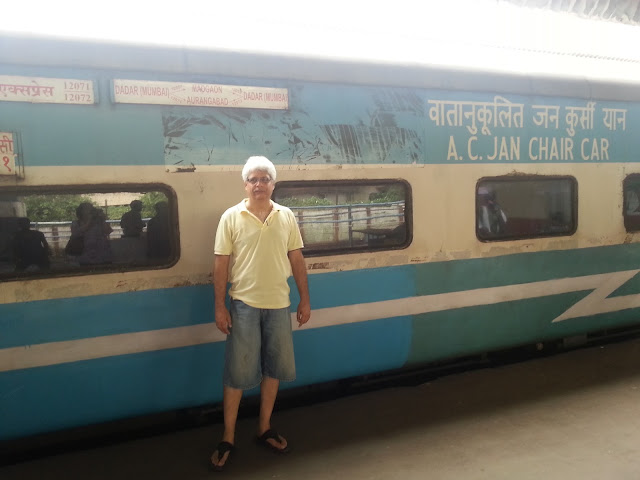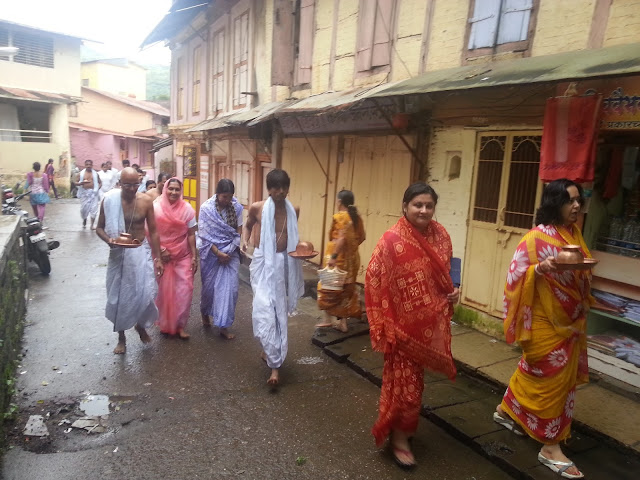Trimbakeshwar - Ideal venue to perform Puja Ceremonies for the salvation of the departed souls in the family
Why Trimbakeshwar?
Its closest from Mumbai 🙂. Moreover, Trimbakeshwar (Tryambakeshwar or Trambakeshwar) temple is one out of the twelve 'Jyotirlingas' dedicated to Lord Shiva. It takes its name from 'Trimbaka', which means The Lord who has three eyes.This sacred Hindu temple is unique as it host 3 Lingas as one, each representing Brahma, Vishnu and Shiva. Unlike other Jyotirling's, this Linga is almost submerged in the ground covered with Godavri river water in a hollow space. The temple lies in the foothills of mountain Brahmagiri which is the origin of river Ganaga ( called as Godavri here). This place is believed to be the holiest and ideal place to do Shraddha ceremony, a Hindu ritual for the salvation of the departed souls in the family.
So our journey begins:
 |
| Boarding Train from Dadar to Nasik 140 kms.
It was a pleasant ride covering a distance of 140 Kms. in 3 hours 30 mts. We hired a Taxi from Nasik Railway station that reached us to our destination at Trimbakeshwar covering a distance of about 35kms in 40 minutes. We had arranged with Pandit Kishorshastri Patankar for boarding and lodging including Pujas for Narayan Nagbali, Kalsarp Yog and Tripendi Shraddha. The package included, all the necessary that is required to conduct Puja's including clothes that are needed to be worn. You will see me different in the latter part of the blog 🙂. The accommodation consisted of just bare, repeat bare necessities only, with no frills of any sort, except for being in an atmosphere of beautiful natural surroundings with simple living and simple thinking attitude.
|
 |
| Central point at Trimakeshwar Village, Buses, Auto-rickshaws all embark and disembark here.
We met a very nice couple from Delhi, Shweta and Nitin Bhargawa.
|
We stayed 3 night in this small village under the umbrella of Pundit Kishorji and his team guiding us with the rituals and ceremonies of the Pujas to be performed on each day. Mostly, all the ceremonies were conducted early morning.
Day 1 - Grand Havan Puja
A Havan is a sacred ritual in which offerings are made to the fire. Fire has been regarded as God in the Hindu religion. Hence, the offerings made to the sacred fire is said to purify the surroundings as well as the individuals. The sacred fire is supposed to be the link between human consciousness and the cosmic consciousness.
Preparations for "Havan" (a sacred fire ceremony in which various forms of the Divine gods and Demi-gods are invoked in a sacred fire that has been kindled according to the guidelines in the Vedic scriptures)
After the morning grand Havan Puja, we took some time out to visit the neighboring surroundings inside the village. It was drizzling but the weather was so awesome that we just could not resist ourselves for a little venture .
 |
| Walking in the nearby surroundings of Trimbak village in mild rain.
Indulging in Local snacks inside the main market of Trimbakeshwar.
|
Day 2 - early morning walking barefoot to Kushavarta Kund
After our dinner at 6pm at the Panditji's Dinning hall, we all were briefed about the next day's schedule. We had wake up by the sound of alarm bell that will be triggered in the corridors of our accommodation at 4am. We have to collect hot water in the buckets from 2 locations for taking a bath, wear a Dhoti for men and Yellow Sari for women and meet outside the Dinning Hall sharp at 5am. We then need to walk for 10 to 12 minutes to Kushavarta Kund (a sacred pond which is considered the source of Godavri river) and take a dip inside this holy pond.
Significance of Kushavarta Kund
There is an interesting account explaining the significance of the place. Sage Gautam once committed a sin of killing a cow. As an act of repentance, He performed penance at the peaks of the Brahmagiri Mountains, appeased Lord Shiva and asked for the Ganga waters so that he could wipe off his sin. Pleased with his devotion, Lord Shiva jerked His big locks of matted hairs on the Brahmagiri Mountains and sent Ganga down onto the earth. Today that place is known as Gangadwar, situated half way to the Brahmagiri Mountains. There is a temple of Ganga, now known as Godavari River. Ganga appears first time here, after which it vanishes.
But the flow of the Ganges was tremendous due to which the sage could not bathe in her waters. He then surrounded the river with Kusha, a type of grass and put a stop to her flow. After bathing here his sin of killing a cow was finally wiped off. The tirth (pilgrimage) came to be known as Kushavart.
Thus today, Kushavart is known as the symbolic origin of the River Godavari. It is from this Kushavart that the river Godavari flows up to the sea. There are temples at the four corners of Kushavart.
But the flow of the Ganges was tremendous due to which the sage could not bathe in her waters. He then surrounded the river with Kusha, a type of grass and put a stop to her flow. After bathing here his sin of killing a cow was finally wiped off. The tirth (pilgrimage) came to be known as Kushavart.
Thus today, Kushavart is known as the symbolic origin of the River Godavari. It is from this Kushavart that the river Godavari flows up to the sea. There are temples at the four corners of Kushavart.
(above excerpts credits to My Yatra Diary)
Day 3 - Tripindi Shraddha Puja at Trimbakeshwar Temple
The concept of Shraddha is ritual of forefathers performed faithfully by their descendants.
Hindus believe that the soul is immortal. It's important that the soul departs in peace and meet with its divine spirits. As such, Hindus offer prayers, feed cows, birds, dogs, perform good deeds and donate to the needy every year for the departed souls and their ancestors of the family. It is believed that if Shraddha is not done continuously for 3 years, then the departed soul is not a happy soul thus causing hardships, delays, loss and all sorts of negative effects to the family members. Thus to give salvation to the ancestors, it is recommended to perform Tripendi Shraddha / Narayan Nagbali.
Photography was strictly restricted inside the above Trimakeshwar Temple
 |
| Trimbakeshwar Temple. Photo credits: By Niraj Suryawanshi |











Comments
Post a Comment